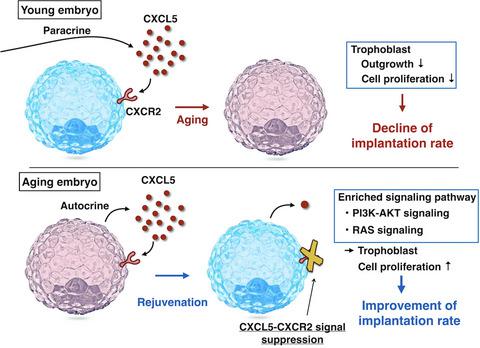当前位置:
X-MOL 学术
›
Aging Cell
›
论文详情
Our official English website, www.x-mol.net, welcomes your
feedback! (Note: you will need to create a separate account there.)
CXCL5-CXCR2 signaling is a senescence-associated secretory phenotype in preimplantation embryos.
Aging Cell ( IF 8.0 ) Pub Date : 2020-09-22 , DOI: 10.1111/acel.13240
Yuta Kawagoe 1, 2 , Ikko Kawashima 3 , Yorino Sato 1 , Naoki Okamoto 1 , Kazuei Matsubara 2 , Kazuhiro Kawamura 1
Aging Cell ( IF 8.0 ) Pub Date : 2020-09-22 , DOI: 10.1111/acel.13240
Yuta Kawagoe 1, 2 , Ikko Kawashima 3 , Yorino Sato 1 , Naoki Okamoto 1 , Kazuei Matsubara 2 , Kazuhiro Kawamura 1
Affiliation

|
Pregnancy rate of women decreases with age due to declining quality of oocytes and embryos. However, there is no established method to improve pregnancy rate in aging women. In this study, we identified a senescence‐associated secretory phenotype (SASP) factor partially responsible for the decline in embryo implantation potential. Based on microarray analysis using young and aging human embryos at the same morphological grade, 702 genes showed >fivefold increases in aging human blastocysts. Among these genes, C‐X‐C motif chemokine 5 (CXCL5) showed 7.7‐fold increases in aging human blastocysts. However, no‐age‐dependent changes in expression of the CXCR2, the cognate receptor for CXCL5, were found. In aging mice, Cxcl5 transcript levels were also increased in oocytes and embryos. Treatment of young mouse embryos with CXCL5 decreased implantation rates, together with increased expression of aging markers (P53, P21, Pai‐1, and Il‐6). Moreover, CXCL5 treatment suppressed trophoblast outgrowth in young mouse blastocysts. Conversely, suppression of CXCL5‐CXCR2 signaling in aging mouse embryos using neutralizing antibodies and a receptor antagonist improved the implantation rate, leading to increases in pregnancy and delivery of normal pups. The gene expression pattern of these embryos was comparable to that in young mouse embryos showing enriched cell proliferation‐related pathways. In conclusion, we identified CXCL5 as a SASP factor in human and mouse embryos and suppression of CXCL5‐CXCR2 signaling during embryo culture improved pregnancy success in aging mice. Future analysis on CXCL5‐CXCR2 signaling suppression in human embryos could be the basis to improve embryo development and pregnancy outcome in middle‐aged infertile patients.
中文翻译:

CXCL5-CXCR2 信号是植入前胚胎中与衰老相关的分泌表型。
由于卵母细胞和胚胎的质量下降,女性的怀孕率随着年龄的增长而下降。然而,没有既定的方法来提高老年妇女的怀孕率。在这项研究中,我们确定了一种与衰老相关的分泌表型 (SASP) 因子,该因子是导致胚胎着床潜力下降的部分原因。基于使用相同形态级别的年轻和衰老人类胚胎的微阵列分析,702 个基因显示衰老人类囊胚增加了 5 倍以上。在这些基因中,C-X-C 基序趋化因子 5 ( CXCL5 ) 在老化的人类囊胚中增加了 7.7 倍。然而,发现 CXCR2(CXCL5 的同源受体)的表达没有年龄依赖性变化。在衰老小鼠中,Cxcl5卵母细胞和胚胎中的转录水平也增加了。用 CXCL5 处理年轻小鼠胚胎会降低着床率,同时增加衰老标志物(P53、P21、Pai - 1和Il - 6)的表达)。此外,CXCL5 处理抑制了幼鼠囊胚中的滋养层生长。相反,使用中和抗体和受体拮抗剂抑制衰老小鼠胚胎中的 CXCL5-CXCR2 信号传导可提高着床率,从而增加正常幼崽的怀孕和分娩。这些胚胎的基因表达模式与显示丰富的细胞增殖相关途径的年轻小鼠胚胎的基因表达模式相当。总之,我们将 CXCL5 鉴定为人和小鼠胚胎中的 SASP 因子,并且在胚胎培养过程中抑制 CXCL5-CXCR2 信号可以提高衰老小鼠的妊娠成功率。未来对人类胚胎中 CXCL5-CXCR2 信号抑制的分析可能是改善中年不育患者胚胎发育和妊娠结局的基础。
更新日期:2020-10-23
中文翻译:

CXCL5-CXCR2 信号是植入前胚胎中与衰老相关的分泌表型。
由于卵母细胞和胚胎的质量下降,女性的怀孕率随着年龄的增长而下降。然而,没有既定的方法来提高老年妇女的怀孕率。在这项研究中,我们确定了一种与衰老相关的分泌表型 (SASP) 因子,该因子是导致胚胎着床潜力下降的部分原因。基于使用相同形态级别的年轻和衰老人类胚胎的微阵列分析,702 个基因显示衰老人类囊胚增加了 5 倍以上。在这些基因中,C-X-C 基序趋化因子 5 ( CXCL5 ) 在老化的人类囊胚中增加了 7.7 倍。然而,发现 CXCR2(CXCL5 的同源受体)的表达没有年龄依赖性变化。在衰老小鼠中,Cxcl5卵母细胞和胚胎中的转录水平也增加了。用 CXCL5 处理年轻小鼠胚胎会降低着床率,同时增加衰老标志物(P53、P21、Pai - 1和Il - 6)的表达)。此外,CXCL5 处理抑制了幼鼠囊胚中的滋养层生长。相反,使用中和抗体和受体拮抗剂抑制衰老小鼠胚胎中的 CXCL5-CXCR2 信号传导可提高着床率,从而增加正常幼崽的怀孕和分娩。这些胚胎的基因表达模式与显示丰富的细胞增殖相关途径的年轻小鼠胚胎的基因表达模式相当。总之,我们将 CXCL5 鉴定为人和小鼠胚胎中的 SASP 因子,并且在胚胎培养过程中抑制 CXCL5-CXCR2 信号可以提高衰老小鼠的妊娠成功率。未来对人类胚胎中 CXCL5-CXCR2 信号抑制的分析可能是改善中年不育患者胚胎发育和妊娠结局的基础。

































 京公网安备 11010802027423号
京公网安备 11010802027423号